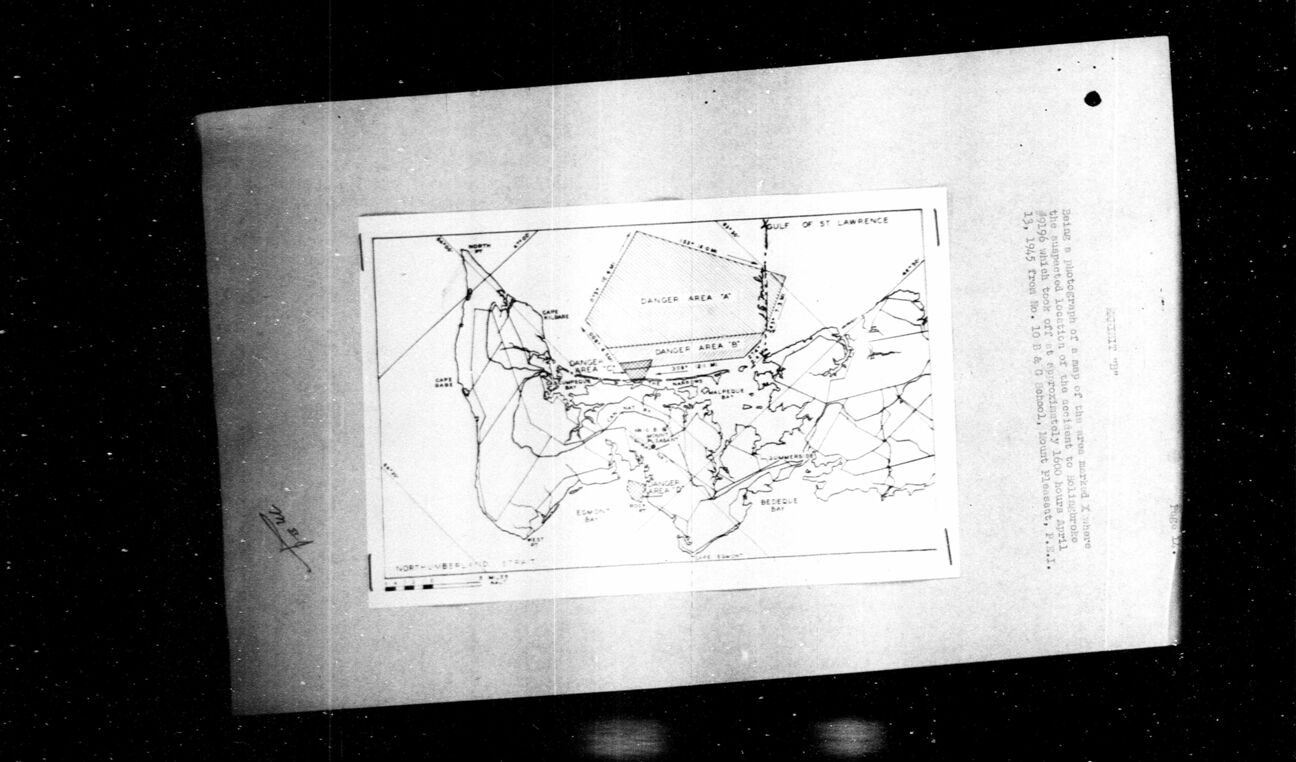
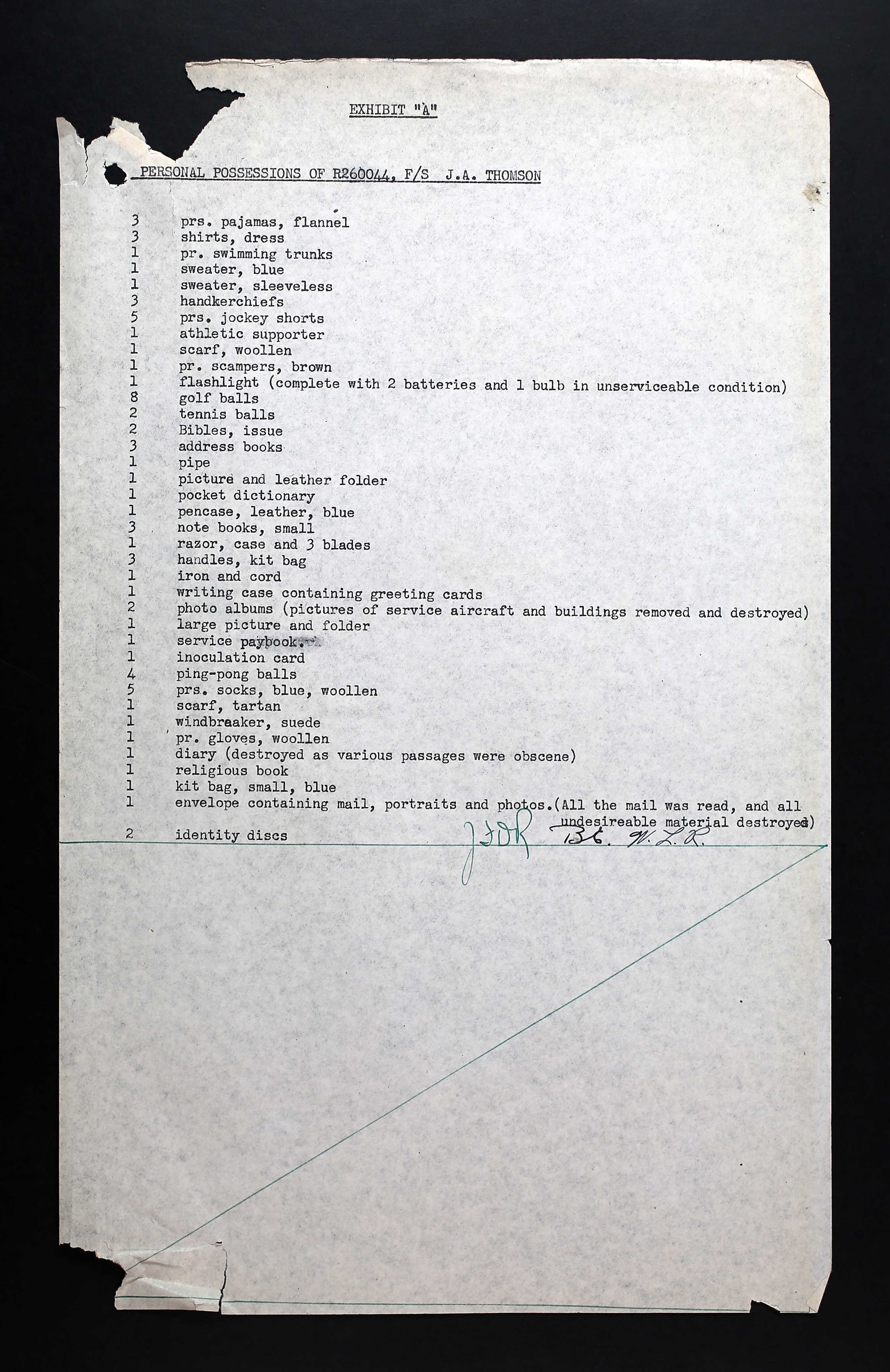
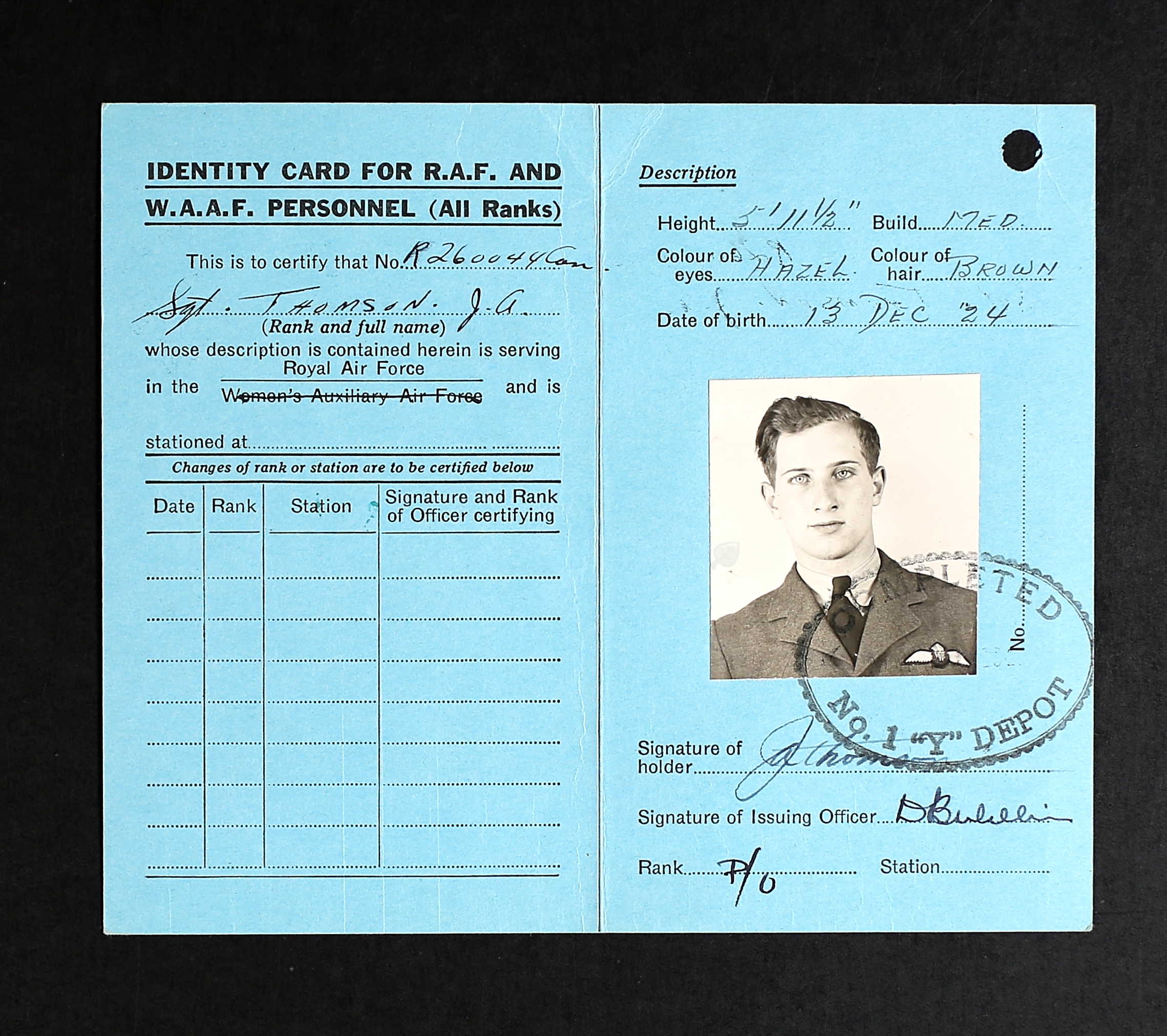
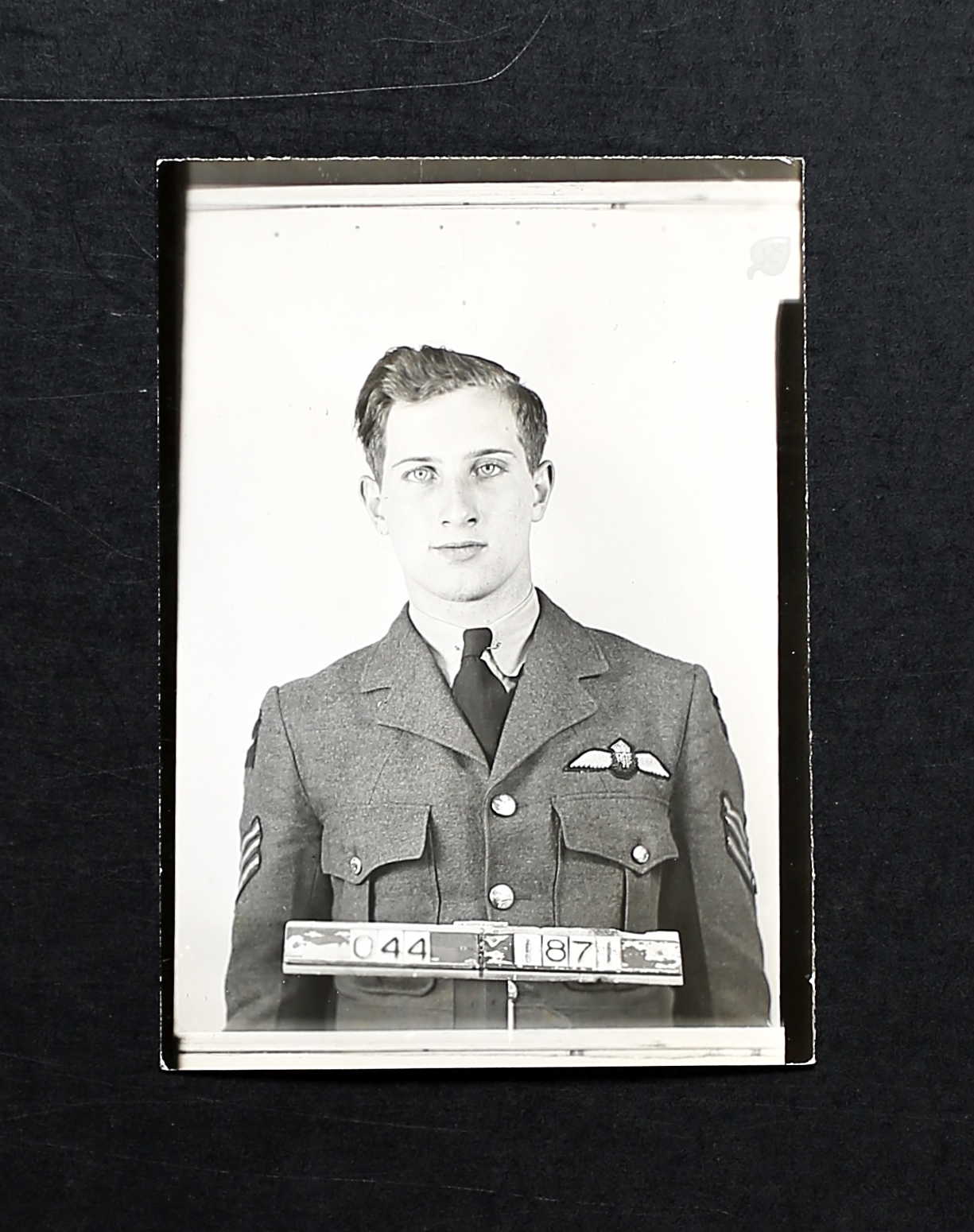
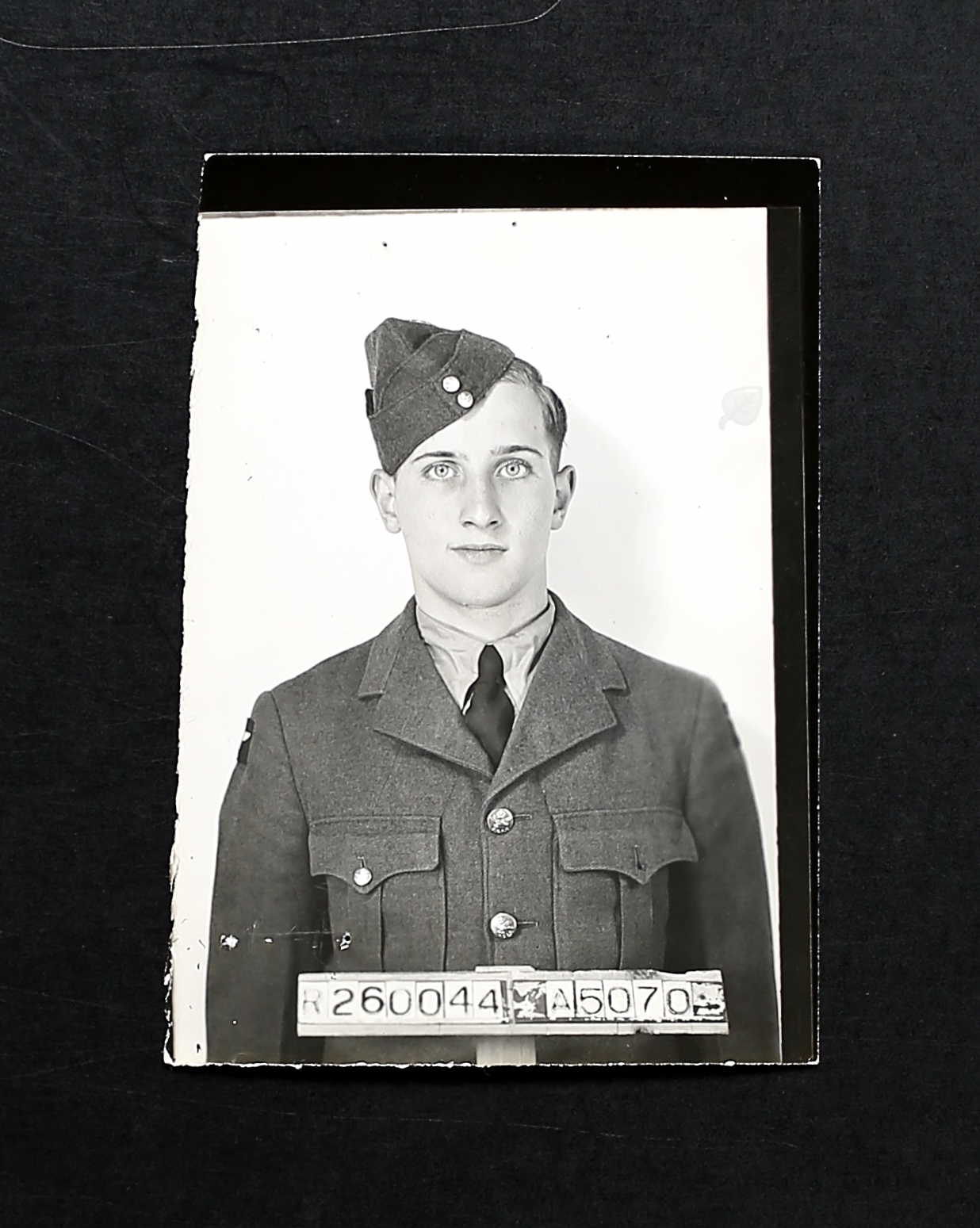
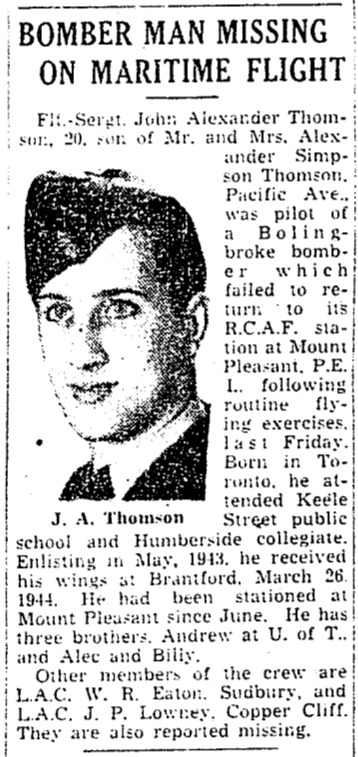
December 13, 1924 - April 13, 1945






John Alexander Thomson was the son of Alexander Simpson Thomson, painter, and Mabel Lucy (nee Moorhouse) Thomson of Toronto, Ontario. He had three brothers (Andrew Moorhouse Thomson, Alexander Gowald Clifford Thomson, and William Wallace Thomson), one with suspected tuberculosis. Another brother, named Victor, died in December 1938. John indicated he had another brother who died as a child.
He had a Grade XI education and worked at Robert Simpson Co. in the collections department from 1941-1943. He enjoyed hockey, rugby, and baseball. He stood 71” tall and weighed 153 pounds. He had a scar under his chin; moles and freckles across the back of his shoulder were noted. He had brown eyes and brown hair, with a dark complexion. Teeth were carious and stained. The medical officer’s assessment in May 1943: “Very good physically and mentally. Also in appearance and manner. Perhaps a trifle self-impressed and spoiled, but will improve in the service. Very good material with commission possibilities if education good enough.” The interviewing officer’s assessment: “Good steady gentlemanly lad, with no mature development or ideas. Good material. Service will do wonders for his lad. Will succeed.” John indicated he could speak some French. He had RCOC (R) experience in ordinance in Toronto, and was a Private. He hoped to remain in aviation after the war. His motivation was he was “tired of working.” The assessment of another interviewing officer, F/L L. F. Belanger at No. 5 Manning Depot: “Follows crowd. Young, immature, careless. Lacks seriousness and self-discipline. Has never done much in life yet and it does not look like if she should be outstanding here either. Borderline case, not impressive as aircrew material. Education: 3 years HS. Intelligence average. Emotional stability and General adjustment: fair.”
At No. 3 ITS, June 28 to September 3, 1943: “Young and immature, but bright. Keen and capable of doing better. Should improve with further experience in the service. Selected as pilot. Alternative recommendation: air bomber. 50%: assessment of qualities of character and leadership. 71% examination results.”
He was sent to No. 14 EFTS, Windsor Mills, September 6 to October 29, 1943. “Ground: 80.7% Flying: 69.2%. 220/300 (73%) Assessment of Qualities of Character and Leadership. Definitely suitable on Bomber type aircraft. Moderately suitable: fighter and instructor. Average. Forced landings and aerobatics weak. Instruments average. Unusual positions a little weak.”
John was at No. 5 SFTS, Brantford, Ontario, from November 1, 1943 until March 24, 1944. On November 14, 1943, John was involved in a taxiing accident in Anson 8492 and was confined to barracks for fourteen days. Ground Examinations: 73/1%. Flying Tests: 68.6%. Assessments of Qualities of Character and Leadership: 38.5%. John was seen as moderately suitable for bomber, fighter, general reconnaissance, army co-op aircraft, flying boats and as an instructor. “Immature but with average ability.”
He was then posted to No. 3 AGTS, Three Rivers (Trois Rivieres), Quebec, April 8 until May 6, 1944. John was next sent to Lachine, then taken on strength with No. 10 B&G School, Mount Pleasant, PEI as of June 1, 1944.
He was the pilot of Bolingbroke 9196 along with two drogue operators and one armourer. On April 13, 1945, they were all lost during a drogue flight off the coast of Prince Edward Island.
A court of inquiry was struck and six witnesses were called. [Microfiche T12353, image 5646] F/S John Alexander Thomson, pilot, LAC Walter Ronald Eaton, drogue operator, LAC Harold Ferguson McBride, drogue operator, and LAC Joseph Patrick Lowney, armourer, were all missing. “Staff Pilot Thomson total flying time 524.35 hours. Time on type: 277.35 hrs. His F/C stated that his flying ability was ‘above average’ and that he had no bad flying habits. DESCRIPTION OF FLIGHT: The aircraft took off at 1600 hours on the flight which had been authorized for routine drogue towing some time earlier and before an instruction had been issued by the I.I. that dispatch was to stop at 1600 hours. At this time, the Control Officer on duty saw two aircraft starting up but neither of these aircraft asked for take-off clearance nor was identified by the Tower. At 1720 hours, the aircraft, which had not been heard of or seen since take-off, was reported overdue and a search was begun for it. Before dark, an oil slick and a deflated dinghy was spotted in the gulf fifteen miles off Cape Aylesbury, 25 miles NE of base. There were small pieces of wreckage floating in the oil slick, but there was no other sign of an aircraft or its passengers. A report of this discovery could not be transmitted by the pilot who made it, because the radio in his aircraft was unserviceable and consequently it was not until he returned to base at dark that he was able to relate what he had seen. The search was continued the following morning by aircraft and by a party in a poorly equipped boat secured from a civilian. The dinghy was located again from the air but there was a heavy sea rolling and before it could be reached the dinghy had sunk and disappeared. The aircraft and its occupants are still missing. FINDINGS OF INVESTIGATION: Cause: unknown. RECOMMENDATIONS: 1. Crash boat on duty when operations over water are in progress. 2. Dinghy practice and lectures be instituted immediately. 3. That a training flight be established in which a definite programme is set up similar to other units to include regular schedules of instruction on link, all instrument practices and clear hood checks. CONCLUSIONS OF AIB: Aircraft missing. NOTE 1: Two of the missing airmen, LAC Lowney and LAC Eaton went on the flight without the authorization or knowledge of the OC, the Flight who signed the F.17. This officer stated that the names of Lowney and Eaton had been inserted on the F.17 after he had initialed it as authorizing Officer. On May 2, 1945, an unauthorized airman passenger was one of the persons killed in the crash of Bolingbroke 10098 from this same unit. NOTE 2: The F.17 on which the flight was recorded did not have Column B (time to take-off) nor Column 9 (duration of flight) filled in for the subject flight, or any of the flights shown thereon except one. NOTE 3: There was evidence that the pilots at this unit did not customarily wear Mae West. NOTE 4: Dinghy drill was not held at the Unit. NOTE 5: At the time of this accident, the crash boats of the Unit’s Marine Section had not been made ready for service. There were no tradesmen on strength of the unit to do this work or to operate the boats. NOTE 6: While it appeared in evidence that it was the practice for Drogue Flight aircraft to check their radios on the ground and get clearance before take-off, there was no written order requiring this procedure to be followed. NOTE 7: After the investigation, the AOC, No. 1 Air Command visited the Unit to inquire into the matters related by this investigation and referred to above. The CO’s reply to questions raised by the AOC are contained in Appendix B to the proceedings of the investigation.”
The first witness, Flying Officer Arthur Edward McKenna, J29629, O/C Drogue Flight at No. 10 B&G School, Mount Pleasant, PEI: stated that “this was a drogue exercise being a gunnery exercise where in an aircraft from that flight fires on the drogue towed by an aircraft from drogue flight. It is usual for Despatch Flight to phone the drogue flight and request a number of aircraft from them for whatever number of lines they require. I was in the air at the time and I am not conversant with the exact nature of the request. The normal crew for a drogue ship is pilot and drogue operator. I presume the extra passengers carried were given an familiarization flight. It is customary if the men make the request and have proper consent, and that would be O/C Flying, Chief Instructor, of the Flight Commander. The aircraft has a dinghy and the crew should wear ‘wests’ the aircraft is radio equipped and has signal flares. This unit does not have dinghy drill. Normally, there is a crash launch in attendance when exercises are over water, but on this occasion, it has not yet been put into service owing to the early spring. Gunnery crews are briefed on their exercises and my pilot and crew are not briefed as they carry out a definite procedure for every type of exercise. I’ve know F/S Thomson for nine months. He was quiet and reserved and on several occasions, has shown his ability to be an above average pilot. I do not know of him having any bad habits, either personal or in flying. He was definitely not a ‘show off’ but was popular and mixed will in the flight.”
The second witness, Flying Officer, T. Albert Alexander, J25251, staff pilot, No. 1 R and NS, Summerside, PEI: “On Friday evening, April 13th 1945, night flying at the above unit having been washed out, a number of pilots were sitting around the mess when the call came through for four night flying pilots. I volunteered and discovered it was a search for a missing aircraft from No. 10 B&G School, Mount Pleasant, Prince Edward Island. Arrangements were made in flying control whereby the pilots would set course at Cape Aylesbury on a true track a 45 degrees until intervals of four miles had been reached, then alter course to a true track of 315 degrees. I was piloted #4 aircraft and was airborne from base at 1935 hours. My second pilot sighted something about one or two miles straight ahead approximately 12 to 15 hour miles out of Cape Aylesbury. I had been flying at 500 feet and immediately let down to 100 feet. 1/5 aircraft had joined the search and was about two miles from me on my starboard side. I immediately fired two red flares to attract his attention but he did not see me. Appan nearing the object on the water, we discovered it was a yellow dinghy which was unoccupied. In my opinion, the dinghy appeared to be practically deflated. I dropped several flame floats to mark the position of the D then increased my circles to find any other evidence on the crash and discovered an oil slick composed of three or four long patches. This I would estimate to be four or 500 yards long on the windward side of the dinghy. Very small pieces of wood or wreckage could be seen floating in the oil. No other evidence could be found so I returned to the dinghy, climbed to 1000 feet and tried to attract the other aircraft by firing red flares. Unfortunately, my radio was unservicable and I could not contact base or the other aircraft. During the evening search, the sea was very common at the time of my takeoff, the weather was if I recall correctly, light overcast but visibility was very good. A light sea breeze was blowing all during the search. After approximately 40 minutes of circling the dinghy, it was getting almost too dark to see the dinghy and there was no hope of getting any other aircraft on the scene of this accident, so I returned to base and reported what I had found. The following morning, the dinghy could not be found so I requested to see if I could locate it again. I was airborne at 11:10 hours and again flew the same track as the previous night, canceling drift. After six and a half minutes on this track at about 120 mph, IAS, I discovered the dinghy just off my port wingtip. The wind was very strong at about 235/30K. Quite a heavy sea was running therefore I had difficulty in keeping the dinghy insight. I dispatched a message to base by W. T. Giving approximate position and tried to contact the other aircraft that was with me on the search by R. T. But was unable to do so. I then proceeded to mark the position of the dinghy again with flame floats and in doing so, flew very low over the dinghy and have three or four very good looks at the dinghy. The dinghy, in my opinion, was definitely deflated and there appeared to be dried salt on the bottom of it, which later I found to be talcum powder. My information came from observing same type of dinghy at the dinghy room at No. 10 B&G School… I believe the dinghy could have gone under. Previous to my takeoff, a small boat had been dispatched to try to pick up the dinghy. Our only method of contact with same was by Aldis lamp… I was running short of gasoline after three hours and 55 minutes. After half an hour on the ground, I was airborne again at 1510 hours and repeated the whole procedure carrying out every type of search imaginable, but was unable to locate the dinghy, so again returned to base being airborne this flight 2 hours 30 minutes.”
The third witness, Pilot Officer L. Phillp Adam, J886_7, dispatcher in Gunnery Flight, No. 10 B&G School: my duties as a dispatcher, in cooperation with drug flight, I arrange for pilots and students of gunnery flight to carry out certain exercises for which they have already been briefed in accordance with the number of aircraft available from drogue flight and gunnery flight. Drogue pilots take off and when these aircraft are seen to take off, I send off gunnery crews for certain specific exercises. We had no exercises scheduled for 1600 hours or after. There was no permission asked at our flight that Lac Lowney be permitted to accompany a drogue aircraft as passenger. The weather was light winds and very light fleecy cloud at a greater height than the 2500 feet at which any exercises are normally carried out, practically CAVU.”
The fourth witness, Flying Officer J. Bennett McLaughlin, J46707, Control Officer at No. 10 B&G School: “on April 13th 1945 at about 1720 hours, I reported to the O/C flying that Bolingbrook 9196 was overdue and on checking with ‘midway,’ the name of our radio room, ascertained that no R. T. message had been received from the above aircraft. I did not see the aircraft takeoff nor the position of the occupants in the said aircraft. Following the reporting of this aircraft as missing, the procedures as laid down was followed by an endeavour to ascertain its whereabouts. On actual drogue exercises, aircraft are not to take off if the radio is une serviceable. When at 1600 hours I saw two drone aircraft starting up and not being aware of the number of these aircraft, I called Drogue Flight over the PA system and asked her reason for these two aircraft starting their takeoff. The reply was that one was going up on circuits end bumps and that a gunnery aircraft was waiting on the range for the other period not knowing the number of these aircraft, I unable to state whether Bolingbrook 9196 was either of these two aircraft.”
The fifth witness, Wing Commander Guy Vadboncoeur (1909-2007), C715, Chief Instructor, No. 10 B&G: “on April 13th, 1945 at approximately 1540 hours, pilot Thompson was authorized by flying officer fohn, OC drogue flight to carry out a drogue exercise in Bolingbrook 9196. Flight Sergeant Thomson took off at 1600 hours without contacting the control tower by radio, carrying within two drogue operators namely LACs Eaton and McBride, and an armorer LAC Lowney. Flight Sergeant Thompson did not report any exercises complete nor is he reported to have steamed a drogue. He was not in radio contact with the control tower at anytime. At 1720 hours he was reported overdue to me… immediately a search of the island was organized, the Harvard, 1 Anson, and for Bolingbrook being sent out…. Summerside and Charlottetown RCAF schools were notified and five answers were dispatched from Summerside to search an area along the North Shore of P. E. I. Had approximately 2000 hours one of the pilots from Summerside saw a dinghy practically deflated, a small amount of wreckage and oil slick on the water…. The extra two passengers in Bolingbroke aircraft 9196 cannot be explained by the undersigned as the OC C and has instructions not to carry passengers and rogue aircraft. If they have carried out this practice, it is against any instructions. One extra drogue operator however may be carried on a familiarization trip in order to brief him on the work or procedure which is to be carried out for the streaming drogues… it would appear that it is the practice in drogue flight to authorize more than one flight prior to the actual dispatch of these aircraft. It is not the proper procedure as these aircraft must be authorized just before taking off. However on the afternoon in question, instructions were given by the undersigned that dispatch was to be stopped at 1600 hours due to the fact that the training program was well in advance of schedule. Unfortunately Flight Sergeant Thompson took it upon himself to take off on a flight authorized sometime prior to departure. Contrary to instructions, he did not check his radio or report to the control tower by RT with the consequences that if this practice had been carried out according to instructions, he would have been immediately recalled and their loss would not have occurred.”
The sixth witness, F/O Harry F. Fase OC Drogue Flight, No. 10 B&G School, gave his testimony after he returned from leave. “These are my initials on the F-17 authorizing the flight. I did not see the aircraft take off. I received information at 1615 hours that no more gunnery exercises were to take off. I had left the flight at about 1530 hours after making the usual arrangements to keep a drogue ship in the air available for normal gunnery exercises. My reason for leaving the flight was that it was anticipated that I pilot Wing Commander Vadboncouer and the CO to Mont Joli, QC. In the morning, the gunnery flight phone over to drogue flight and advise us that a certain number of drogue ships aren't required. We work out the necessary numbers of our drogue ships that are to be on the line and when the exercises completed, the drogue pilot sends an RT message ‘exercise completed’ and gunnery flight send up another aircraft to carry on. It does not necessarily follow that an aircraft taking off on an exercise uses the drogue ship on the line but may pick up one on the rendezvous. There is not a definite allocation by number of one gunnery aircraft to use a specific drogue ship. The instructions regarding drogue aircraft notifying ‘midway’ Aunt a cough is that and artecoll to make sure radio is working is sent while the drogue ship is on the tarmac but I do not know if this is laid down as a specific order. Aircraft are not recalled from taking off on this unit because they have not cleared with the tower. I do not know of any order to the effect wearing of Mae West's although the students always wear them but I know I am correct in saying that seldom does a pilot wear one. There is no practical dinghy drill but since the new year I recall one lecture to the pilots only. The drogue operators do not receive any nor am I aware of any to the pilots. The crash boat was not in attendance as it was on its way to Charlottetown. Passenger Lowney did not obtain any permission to accompany the flight from us. if a mechanic who has been working on an aircraft wishes to go up, I believe it is laid down in a previous order that he is to be encouraged to fill an unoccupied seat on the flight. If an outsider wishes to go as an excess passenger, I personally require a chit that he has been given permission by either the OC Flying or his flight commander authorizing him to proceed. If an extra drogue operator wishes to go up to familiarize himself with the operation of streaming drogues etc we do not deter him from doing so. At this point I wish to point out that on the F.17 when I authorize the flight the only names authorized by me were Thompson and Eaton, the other two names McBride and Lowney were added subsequently. I normally do not object to them adding a drogue operator. I do not know who made this alteration on the F.17. Since I act as drogue pilot myself and I'm not always on the ground, the program is authorized and not necessarily the flights individually. Actually, I normally authorized two or three flights at a time. All staff pilots receive at least two hours link a month but swing to the lack of instructor recently, no hood or instrument practices have been laid down. Only if the pilot is keen and wishes to do some practice under mutual instruction while they are on 48s is any training practice effected. Either the pilot’s radio did not work and he took off away or knowing that there was no gunnery exercises to be carried out, he wished to go for a joy ride. In the later event if he had called in to ‘midway,’ he would have likely been recalled which he would like to avoid. This is all only a surmise on my part.” When asked if Thomson might have the temperament to indulge in some low flying, Fase replied, “only a thin wall separating my office from the flight room makes it quite easy for me to hear the ordinary flight room chatter. It is my opinion that although the individual pilots are not caught out when blowing off steam, my candid opinion of this pilot is that he may have been indulging in a little bit of unauthorized low flying. Flying discipline as a whole is quite good on this unit. It is very seldom that aerodrome control find it necessary to criticize or check up on poor airmanship. I have no criticism to make of maintenance as they really slug away on their job.”
On May 30, 1945, “the evidence obtained in this investigation discloses a very poor standard of flying discipline at this unit but as you will see the AOC made a personal visit to the station and it appears that the matter is now under control.
His parents wrote, “He told us that he had an account in the post office (we presume in the camp at Mount Pleasant) Prince Edward Island. We don’t know how much. The Victory Bonds mentioned were, if any, singed over by him to his mother three months before he was killed.” In John’s personal effects, he had two photo albums. Pictures of service aircraft and buildings were removed and destroyed. He also had a diary, and it was destroyed as “various passages were obscene.” One envelope containing mail, portraits and photos. The mail was read and all ‘undesirable material was destroyed.” He also had two Bibles.